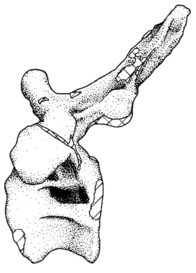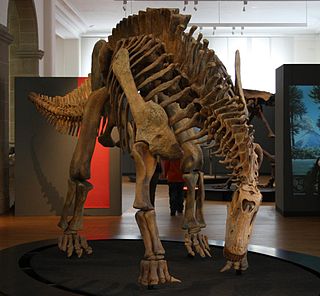
Apatosaurus is a genus of herbivorous sauropod dinosaur that lived in North America during the Late Jurassic period. Othniel Charles Marsh described and named the first-known species, A. ajax, in 1877, and a second species, A. louisae, was discovered and named by William H. Holland in 1916. Apatosaurus lived about 152 to 151 million years ago (mya), during the late Kimmeridgian to early Tithonian age, and are now known from fossils in the Morrison Formation of modern-day Colorado, Oklahoma, New Mexico, Wyoming, and Utah in the United States. Apatosaurus had an average length of 21–23 m (69–75 ft), and an average mass of 16.4–22.4 t. A few specimens indicate a maximum length of 11–30% greater than average and a mass of approximately 33 t.

Camarasaurus was a genus of quadrupedal, herbivorous dinosaurs and is the most common North American sauropod fossil. Its fossil remains have been found in the Morrison Formation, dating to the Late Jurassic epoch, between 155 and 145 million years ago.

Diplodocids, or members of the family Diplodocidae, are a group of sauropod dinosaurs. The family includes some of the longest creatures ever to walk the Earth, including Diplodocus and Supersaurus, some of which may have reached lengths of up to 42 metres (138 ft).

Haplocanthosaurus is a genus of intermediate sauropod dinosaur. Two species, H. delfsi and H. priscus, are known from incomplete fossil skeletons. It lived during the late Jurassic period, 155 to 152 million years ago. The type species is H. priscus, and the referred species H. delfsi was discovered by a young college student named Edwin Delfs in Colorado, United States. Haplocanthosaurus specimens have been found in the very lowest layer of the Morrison Formation, along with Hesperosaurus mjosi, Brontosaurus yahnahpin, and Allosaurus jimmadseni.
Suuwassea is a genus of dicraeosaurid sauropod dinosaur found in the Upper Jurassic strata of the Morrison Formation, located in southern Carbon County, Montana, United States. The fossil remains were recovered in a series of expeditions during a period spanning the years 1999 and 2000 and were described by J.D. Harris and Peter Dodson in 2004. They consist of a disarticulated but associated partial skeleton, including partial vertebral series and limb bones.

Diplodocoidea is a superfamily of sauropod dinosaurs, which included some of the longest animals of all time, including slender giants like Supersaurus, Diplodocus, Apatosaurus, and Amphicoelias. Most had very long necks and long, whip-like tails; however, one family are the only known sauropods to have re-evolved a short neck, presumably an adaptation for feeding low to the ground. This adaptation was taken to the extreme in the highly specialized sauropod Brachytrachelopan. A study of snout shape and dental microwear in diplodocoids showed that the square snouts, large proportion of pits, and fine subparallel scratches in Apatosaurus, Diplodocus, Nigersaurus, and Rebbachisaurus suggest ground-height nonselective browsing; the narrow snouts of Dicraeosaurus, Suuwassea, and Tornieria and the coarse scratches and gouges on the teeth of Dicraeosaurus suggest mid-height selective browsing in those taxa. This taxon is also noteworthy because diplodocoid sauropods had the highest tooth replacement rates of any vertebrates, as exemplified by Nigersaurus, which had new teeth erupting every 30 days.

Dicraeosauridae is a family of diplodocoid sauropods who are the sister group to Diplodocidae. Dicraeosaurids are a part of the Flagellicaudata, along with Diplodocidae. Dicraeosauridae includes genera such as Amargasaurus, Suuwassea, Dicraeosaurus, and Brachytrachelopan. Specimens of this family have been found in North America, Asia, Africa, and South America. In 2023, a dicraeosaurid fossil was discovered in India for the first time. Their temporal range is from the Early or Middle Jurassic to the Early Cretaceous. Few dicraeosaurids survived into the Cretaceous, the youngest of which was Amargasaurus.

Tornieria is a genus of diplodocid sauropod dinosaur from the Late Jurassic in Lindi Region of Tanzania. It has a convoluted taxonomic history.

Brachytrachelopan is a short-necked sauropod dinosaur from the Late Jurassic of Argentina. The holotype and only known specimen was collected from an erosional exposure of fluvial sandstone within the Cañadón Calcáreo Formation on a hill approximately 25 kilometres (16 mi) north-northeast of Cerro Cóndor, Chubut Province, in west-central Argentina, South America. Though very incomplete, the skeletal elements recovered were found in articulation and include eight cervical, twelve dorsal, and three sacral vertebrae, as well as proximal portions of the posterior cervical ribs and all the dorsal ribs, the distal end of the left femur, the proximal end of the left tibia, and the right ilium. Much of the specimen was probably lost to erosion many years before its discovery. The type species is Brachytrachelopan mesai. The specific name honours Daniel Mesa, a local shepherd who discovered the specimen while searching for lost sheep. The genus name translates as "short-necked Pan", Pan being the god of the shepherds.

Nanosaurus is the name given to a genus of neornithischian dinosaur that lived about 155 to 148 million years ago, during the Late Jurassic-age. Its fossils are known from the Morrison Formation of the south-western United States. The type and only species, Nanosaurus agilis, was described and named by Othniel Charles Marsh in 1877. The taxon has a complicated taxonomic history, largely the work of Marsh and Peter M. Galton, involving the genera Laosaurus, Hallopus, Drinker, Othnielia, and Othnielosaurus, the latter three now being considered to be synonyms of Nanosaurus. It had historically been classified as a hypsilophodont or fabrosaur, types of generalized small bipedal herbivore, but more recent research has abandoned these groupings as paraphyletic and Nanosaurus is today considered a basal member of Neornithischia.

Dyslocosaurus is the name given in 1992 to a genus of sauropod dinosaur from the Late Jurassic Period of Wyoming, North America.
Amargatitanis is a genus of dicraeosaurid sauropod dinosaur from the Barremian-age La Amarga Formation of Neuquén, Argentina. It is known from a single, incomplete postcranial skeleton consisting of a partial hindlimb, ischium, and two vertebrae. These remains were unearthed by Argentine paleontologist José Bonaparte in 1983 during an expedition by the Museo Argentino de Ciencias Naturales and later described as a new genus and species, Amargatitanis macni by Sebastián Apesteguía. The genus name comes from the words Amarga, where the fossils were collected, and titanis meaning "titan". Its species name is in reference to the MACN, where the remains are stored.

Camarasaurus grandis is an extinct species of sauropod dinosaur in the genus that lived during the Jurassic in what is now the western United States. It is the geologically oldest of the four species of the genus Camarasaurus.

Camarasaurus lentus is an extinct species of sauropod dinosaur that lived during the Jurassic period in what is now the western United States. It is one of the four valid species of the well-known genus Camarasaurus. C. lentus fossils have been found in Wyoming, Colorado, and Utah. It is the species of Camarasaurus found in Dinosaur National Monument and the middle layers of the Morrison Formation. Camarasaurus lentus is among the best-known sauropod species, with many specimens known. A juvenile specimen of C. lentus, CM 11338, is the most complete sauropod fossil ever discovered.

Diplodocus is an extinct genus of diplodocid sauropod dinosaurs known from the Late Jurassic of North America. The first fossils of Diplodocus were discovered in 1877 by S. W. Williston. The generic name, coined by Othniel Charles Marsh in 1878, is a Neo-Latin term derived from Greek διπλός (diplos) "double" and δοκός (dokos) "beam", in reference to the double-beamed chevron bones located in the underside of the tail, which were then considered unique.

Kaatedocus is a genus of flagellicaudatan sauropod known from the middle Late Jurassic of northern Wyoming, United States. It is known from well-preserved skull and cervical vertebrae which were collected in the lower part of the Morrison Formation. The type and only species is Kaatedocus siberi, described in 2012 by Emanuel Tschopp and Octávio Mateus.

Leinkupal is a genus of diplodocine sauropod known from the Early Cretaceous of the Bajada Colorada Formation, southeastern Neuquén Basin in the Neuquén Province of Argentina. It contains a single species, Leinkupal laticauda.

Pilmatueia is a diplodocoid sauropod belonging to the family Dicraeosauridae that lived in Argentina during the Early Cretaceous. Its type and only species is Pilmatueia faundezi. Pilmatueia was probably closely related to other South American dicraeosaurids such as Amargasaurus. Pilmatueia had relatively pneumatic vertebrae compared to other dicraeosaurids, which were otherwise characterized by a reduction in pneumaticity relative to other sauropods. Pilmatueia dates to the Valanginian, an age of the Cretaceous period for which dinosaur faunas are poorly known.

Bajadasaurus is a genus of sauropod dinosaur from the Early Cretaceous epoch of northern Patagonia, Argentina. It was first described in 2019 based on a single specimen found in 2010 that includes a largely complete skull and parts of the neck. The only species is Bajadasaurus pronuspinax. The genus is classified as a member of the Dicraeosauridae, a group of relatively small and short-necked sauropods.





























